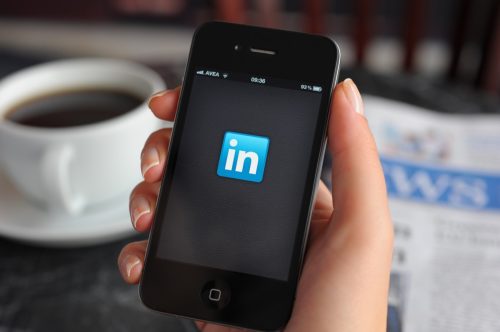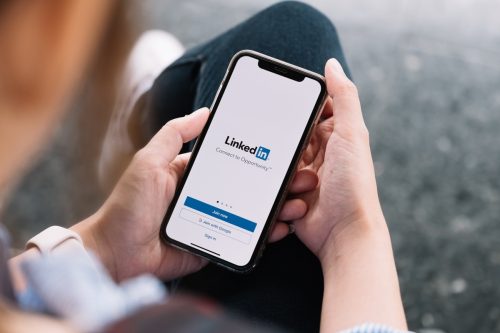How to Build a Strong LinkedIn Profile and Dazzle Future Employers

LinkedIn is like the world’s largest digital networking event—only there’s no free drinks, and the event is never really over. Instead of grabbing people’s attention with the perfect tie or anecdote, your LinkedIn profile is your handshake, and its firmness is based on your page’s details. But do you know how to build a strong LinkedIn profile, and what kind of message are you sending with yours?
Although LinkedIn is a form of social media, it requires a higher level of professionalism and finesse than Instagram or X. Connecting with a potential employer isn’t as simple as sliding into their DMs. LinkedIn is a platform that allows you to showcase your accomplishments by giving job-seekers access to its vast professional network where people can connect with industry leaders and employers. And the best way to get the attention of people you want to connect with is by building your profile into the perfect one. Here are several expert-backed tips you can use to improve your page.
RELATED: How to Ace Every Common Job Interview Question.
How do you create an effective LinkedIn profile?

When crafting your LinkedIn page, it’s important to take the time to analyze who you are as a professional and where you want to be in your career.
“Before you can create an effective LinkedIn profile, you must understand the message you want to communicate to the world and the career goals you are looking to accomplish in the next two to seven years,” says Arissan Nicole, a career coach and workplace and LinkedIn expert. “Once you have clarity around those questions, you can start strategically optimizing your profile.”
Nicole continues, “At the end of the day, LinkedIn is a visual storytelling tool, and you want it to speak for you when you are not in the room and complement the moves you are making in your life outside the platform. It is a living document that needs to be changed and edited on a semi-regular basis. If you want a successful profile, one-and-done editing will not serve you in the long run.”
Much like Rome, your LinkedIn profile won’t be built in a day, as there are many factors that contribute to a strong profile. Vit Koval, a global hiring and remote work advocate at Globy, suggests making sure your profile is complete, “including a professional photo, summary, work experience, and education, with all details in every section of the profile.”
Below, we’ll discuss how to make each part of your LinkedIn shine and highlight who you are as an employee. We’ll also provide tips on how to attract the employer and job that you want.
RELATED: 10 Resume Tips to Help Your CV Stand Out, Experts Say.
1. Improve your profile picture.

A picture can say a thousand words, so make sure your LinkedIn photo says you’re professional and career-oriented. Although you may think your best photos live on Instagram, that’s not the gallery you want to pull from for this profile.
“[Your profile picture] takes a very important space on LinkedIn, being that it forms most of your first impression,” Koval explains. “The right profile picture should be professional, clear, and friendly, portraying a person in business attire or other smart casuals. Make sure the background is not too distracting, the lighting is OK, and your face fills about 60 to 70 percent of the frame.”
Also, make sure your face is centered in the photo.
Daniel Space, a human resources expert advises job seekers not to feel pressured to pay for professional photos for their LinkedIn profiles. Following these guidelines, when done correctly, can be more than enough.
RELATED: Career Expert Reveals the Top-Paying Remote Jobs for 2024.
2. Present your skills and experience in a clear way.
Whether your job experience is extensive or in its early stages, it’s important to focus on the relevant parts of your journey and talents when adding them to your profile’s “Skills” and “Experience” sections.
The information you list in the “Experience” section should detail all your professional responsibilities in a digestible and reader-friendly way. Although you’ll probably need your resume to fill this part out, make sure it doesn’t read like one.
“Under the ‘Experience’ section, highlight achievements rather than listing duties,” Koval notes. “If possible, show how the work you’ve listed [had an effect], with quantifiable results.”
As for the “Endorsement” section of the page, “seek endorsements from colleagues that would add credibility to the enlisted skills,” says Koval.
In other words, it’s OK to be a little picky whose endorsements you make visible on your profile.
According to LinkedIn’s “20 steps to a better LinkedIn profile in 2024,” “once endorsements start to come in, you might find that they skew the emphasis of your LinkedIn profile in ways that don’t reflect who you are.”
There’s nothing wrong with that one super helpful coworker encouraging you on your page in this way, but it shouldn’t be highlighted on your profile if it’s not in line with your current career path. So, don’t be afraid to be selective and “proactive in managing your endorsements list using the edit features in the ‘Skills’ section of your profile—you can choose which to show and which to hide.”
RELATED: 5 Things You Should Never Lie About on Your Resume.
3. Engage with LinkedIn content.

The golden rule of social media is to engage with other people’s posts and profiles the way you want to be engaged with. Although engagement isn’t a requirement, it doesn’t hurt.
“Being active with content involvement and responding to threads on LinkedIn highly rewards job seekers,” Koval shares. “It will make you more visible and showcase your knowledge and passion for your industry. Being a well-known, active member of your professional community because of your good practice in making comments, sharing articles, or even posting thoughtful content, makes you an attractive employee for potential employers.”
LinkedIn is not the place to scroll and lurk, but at the same time, no one is pushing you to become a career influencer who posts about every wholesome workplace encounter. (We all know that person, and we might even judge them!) Don’t be afraid to get in the game and hop on the timeline in your own unique way.
4. Spend time on your headline.
Your headline is one of the first things someone on your profile sees, so make sure it’s grabby and genuinely reflects who you are. But while headlines should pull you in, remember to keep it professional.
“Focus on the first statement in the headline on what you do and who you work with,” says Deb Feder, a business growth coach and CEO of Feder Development, LLC. “This first section of the headline is what is shared across the platform when you post and engage [with] other content. Save your hobbies, interests, and qualifications for later in the headline or within the profile content.”
RELATED: 10 Highest-Paying Jobs That Don’t Require a College Degree, New Data Shows.
5. Optimize your LinkedIn profile.

Without being a data analyst or SEO guru, you can optimize your LinkedIn profile to get the most out of your page and the overall site. It starts with using keywords effectively throughout your profile.
“In order to keyword optimize correctly, you need to look at job postings for roles you want and pull out the specific words companies and recruiters are using,” Nicole explains. “Then make sure those words are in your headline, summary, experience, and skills section. Don’t make your headline too wordy or confusing. If you are looking for project management roles and people leader roles, make sure that is in your headline.”
When recruiters are looking through profiles, they search using keywords based on the role.
“Your headline needs them to think ‘that’s exactly what I’m looking for, I want to know more,’” Nicole says.
Optimizing your profile is about more than just adding the right keywords—it means providing information in a very concise and easy-to-read way. When crafting your headline or any part of your profile, cut out the fluff. Nicole suggests asking yourself, “If this was the only information someone had about you, what is the story it is telling?” or “What is the most important information for them to know?”
“LinkedIn only displays the first 80 words, so make that summary attention-grabbing, and make them want to click ‘see more’ and continue reading,” she adds.
RELATED: 3 “Disappearing” Jobs That Can Make You Rich If You Start Now.
6. Ask for recommendations.
Recommendations are not only reserved for grad school applications and new restaurants to try. One of the most underrated backbones of a strong LinkedIn profile are relevant recommendations that reflect recent accomplishments from LinkedIn connections. So don’t be shy.
Think of it as “a kind of professional ‘social proof’ for recruiters and others who are researching potential new employees,” says Vanessa Francis Gray, a seasoned professional growth coach. “The recommendation provides those users insight into the job seeker’s work ethic, personality, and professional track record.”
But it’s also important to choose the right people to give you a recommendation. Gray suggests picking someone whom you have a personal relationship with and have worked with extensively.
“It would be best if job seekers made the recommendation request first off of the LinkedIn platform,” Gray advises. “Doing so gives the recommender an alert that the request is pending, giving the recommender time to think about what to post.”
RELATED: The 13 Best Ways to Make Money Online, Experts Say.
7. Maximize job search tools.

In addition to making your LinkedIn attractive to employers, you can also make the platform’s job search tools work for you. By looking for jobs on LinkedIn—much like other social media platforms—the site learns what you’re interested in and suggests roles based on your search history. Space suggests spending as little as 10 to 15 minutes three times a week searching through LinkedIn for the jobs you want.
“Once LinkedIn recognizes you as a job-seeker, it will provide you with better experiences such as enhancing your discovery when recruiters are looking for similar roles, in addition to providing recommendations for open roles or soon-to-be open roles,” Space explains.
3 Common LinkedIn mistakes you should avoid

To help ensure you are getting the most out of LinkedIn, steer clear of these common mistakes job-seekers make.
1. Make sure your profile is complete.
Although this may sound very obvious, it’s actually easy to miss. When looking over your profile, make sure all aspects are completed. Incomplete profiles can be viewed as glaring oversights, so just be sure to cover all your bases, Koval recommends.
2. Use LinkedIn as a personal and professional tool.
You are more than your job, and yes, even on LinkedIn. Don’t be afraid to show your personal side (in moderation).
“When folks only talk about their current company or their profile reads like a company puppet, you miss the opportunity to tell your story and showcase your achievements beyond what you do at your company,” Nicole shares.
Again, this is not your Instagram, so instead of dropping subtle digs at your ex, post a picture of yourself completing a marathon or finishing home renovations. Displaying that personal information helps you appear more well-rounded and personable, which is something employers value.
3. Make sure your experience section matches your resume.
Although you don’t want your LinkedIn to read as rigid as your resume, it’s important that they mirror each other.
“Yes, your resume is not going to have everything your LinkedIn does, but if your company names and company dates don’t line up, potential employers will look at that as a red flag,” Nicole cautions.
So, be sure to keep both your LinkedIn and resume updated!
RELATED: 9 Best Side Hustle Ideas to Boost Your Income.
Wrapping Up
Your LinkedIn is like a window into your career, which is why it’s so important to make it a clear and comprehensive experience for those visiting your profile. Your LinkedIn is an opportunity to put your best professional foot forward while still being undeniably you. Follow this advice and take all the time you need to make your profile great.